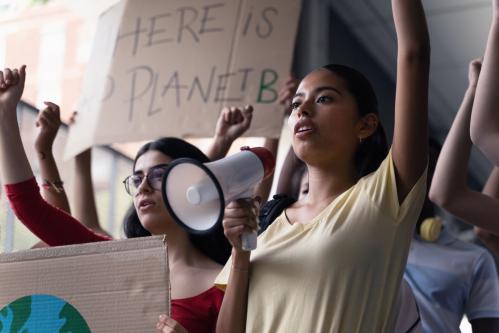On July 22, the U.S. announced its third withdrawal from the United Nations Educational, Scientific, and Cultural Organization (UNESCO), stating in a press release that “continued involvement in UNESCO is not in the national interest of the United States.” In response, Director-General of UNESCO Audrey Azoulay said that the U.S. withdrawal was “regrettable” and “anticipated,” noting that U.S.’ departure “may affect first and foremost our many partners in the United States of America.”
When the U.S. formally leaves UNESCO on December 31, 2026, it will mean losing the chance to be a part of fast-moving and future conversations on global education, culture, and science and to be a collaborator and partner in facilitating peaceful solutions to pressing world challenges. While undoubtedly there are funding implications for UNESCO—an estimated 8% of its annual budget—the U.S.’ departure with no plan for how to participate in future global conversations on topics from generative artificial intelligence (AI) in education to global workforce development should concern all Americans. As two U.S. educators and international education experts who rely on UNESCO’s data and global conversations for research and policy recommendations, we see this withdrawal as further isolating the U.S. in a time when the world is ever-more connected. Although there are undoubtedly reforms and improvements that could be made to improve coordination and efficiency, UNESCO holds a unique space in international collaboration.
What is UNESCO?
With the aim of promoting unity among countries, UNESCO was founded in 1945 immediately after World War II to rebuild destroyed schools, libraries, and museums in Europe. Today, UNESCO continues to promote peace through global cooperation on education and science innovations and to honor and promote cultural preservation, particularly through UNESCO World Heritage Sites. One of the most visited of these sites in the world is the Statue of Liberty, which represents the alliance between the U.S. and France and celebrates the groundbreaking collaboration between art and engineering. Symbolically, the statue is “meant to light the way to freedom” and guide Americans and humankind “toward the path of liberty and justice.”
Today, UNESCO has 194 member states, 200 national commissions, and employs over 2,300 people worldwide who run hundreds of programs and networks that advance science, education, and culture. For example, UNESCO leads a network of over 150 countries reinvigorating technical and vocational education to close the skills gap for young people entering the workforce. They also lead cross-national efforts in science, like a network of parks and reserves in 136 countries–28 of which are located in the U.S. spanning from the Appalachian to the Rocky Mountains and that aim to ensure land and water remains healthy and communities continue to benefit from farming, forestry, fishing, and tourism. The UNESCO Creative Cities Network (UCCN) connects and supports cities—Austin, Kansas City, and Seattle, to name a few—that are using creativity and culture to promote urban development. In example, the UCCN supported the city of San Antonio in their efforts “to create a cultural and arts destination in the heart of downtown” centered around the city’s rich culinary traditions in order to attract visitors and promote economic development. Participation in UNESCO networks and programs ensures that the U.S. not only maintains peaceful relations but can also be a part of cutting-edge efforts in science, education, and culture.
How does the US benefit from being a part of UNESCO?
The U.S., one of the world’s largest economies, has been a major contributor to UNESCO for decades. The U.S.’s contribution is only a small fraction of the federal budget; the annual contribution for 2025 is estimated at $75 million. To think of this in comparative terms, one national cultural event in Washington DC—the June celebration of the 250th anniversary of the army—cost taxpayers $30 million. The U.S. exit signals that the government does not see global collaboration in education, science, and culture as benefitting Americans, and does not see value in advancing global agendas and cooperation. Being a member of UNESCO has benefited the U.S. in myriad ways:
Safer communities. After the 8.8 magnitude earthquake off the Russian coast in July, the UNESCO-coordinated Pacific Tsunami Warning System notified Russia, Japan, and many other countries, including the United States, who proceeded to send out national alerts. UNESCO’s ability to coordinate 46 member countries along the Pacific Rim helps prepare countries for natural disasters.
Guidance on generative AI. UNESCO brings together global leaders to examine the impact of generative AI on education and the workforce. They issued the Guidance for generative AI in education and research in 11 languages to help countries navigate this new frontier and guide the future of generative AI.
Planning for the future of education. Through the Futures of Education project, UNESCO has set forth a plan to reinvent education to address climate change and to work with technology in education. UNESCO convenes experts through its UNESCO University Chairs/UNITWIN Program, which connects researchers—including American faculty members—to take on global challenges like protecting biodiversity. These collaborations help the U.S. stay ahead of the curve on education, not behind it.
Better data for better decisions. The UNESCO Institute of Statistics provides critical data for everyone—from decisionmakers to teachers to the private sector alike—on global trends in education, science and technology, cultural trade, and information, communication, and technology access. The data covers more than 128 countries and spans more than three decades. By providing robust data, UNESCO helps countries see global trends and make decisions on improving education, science, and health.
Keeping peace on the horizon, and war at bay. UNESCO’s legacy is to assist countries during and after war, and to promote peace. Recently, UNESCO has supported, along with other partners, Ukraine in continuing education during the war and in reviving cultural sites in Mosul, Iraq to counter terrorism.
Does the US want to give up its seat at the convening table?
By voluntarily withdrawing from UNESCO, the U.S. will leave a void—beyond just a gap in funding. Without the U.S.’ participation, UNESCO’s initiatives will continue in our absence, but there will be fewer American examples and experts, decreased invitations to join convenings, and a sizable hole in the global consensus.
Moreover, this is the wrong moment to leave. Right now, the U.N. is working to set the global agenda that will follow the Sustainable Development Goals, which expire in 2030. Situating the U.S. at the periphery of decisionmaking on the next era of global priorities, plans, and international cooperation is a mistake. By withdrawing, the U.S. is giving up an opportunity to be involved in shaping future agendas on education, culture, and science and the opportunity to learn from other experts working on these agendas. “The US will be at a significant disadvantage with this withdrawal,” says Barbara Finlayson-Pitts, an atmospheric chemist at the University of California, Irvine. Furthermore, as others have noted, many countries—including China—are eager to fill these spots on committees, put forth their experts for consultations, and nominate their country’s historical sites and university professors for global recognition.
For the price tag, is it worth it for the U.S. to step out and isolate the country from these important global conversations? Is it wise to rescind our involvement in an institution that we built in solidarity with our allies to ensure prosperity after decades of war?
One of the reasons that the Statue of Liberty attracts so many American and global visitors each year is that it demonstrates how a collaboration between an engineer and artist can lead to forward thinking innovation that can withstand weather of any magnitude. It embodies “friendship, peace, and progress” and the hope that humankind can cross into a free and just society. In many ways the statue also represents the intentions of UNESCO: to elevate the best of humanity through collaboration and to ensure that education, science, and culture propel us into our shared future. The Statue of Liberty reminds us in a time when we are charting new waters and crossing new oceans in technology and international diplomacy, how important it is to carry a torch as we navigate the future. Regardless of strength, power, or size, every country needs friends, peace, and progress. We are no exception. The U.S. does not become more innovative, more creative, or more prepared for the future by exiting the UNESCO alliance—it just steps into the periphery with no clear vision of the horizon.
-
Acknowledgements and disclosures
Co-author Anne Campbell previously served as a consultant for UNESCO.
The Brookings Institution is committed to quality, independence, and impact.
We are supported by a diverse array of funders. In line with our values and policies, each Brookings publication represents the sole views of its author(s).





Commentary
What the US loses by exiting UNESCO
August 15, 2025